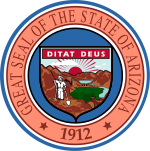
The 1964 United States Senate elections were held on November 3. The 33 seats of Class 1 were contested in regular elections. Special elections were also held to fill vacancies. They coincided with the election of President Lyndon B. Johnson by an overwhelming majority, to a full term. His Democratic Party picked up a net two seats from the Republicans. As of 2023, this was the last time either party has had a two-thirds majority in the Senate, which allowed the Senate Democrats to override a veto, propose constitutional amendments, or convict and expel certain officials without any votes from Senate Republicans. However, internal divisions would have prevented the Democrats from having done so. The Senate election cycle coincided with Democratic gains in the House in the same year.

The Kansas Republican Party is the state affiliate political party in Kansas of the United States Republican Party. The Kansas Republican Party was organized in May 1859.

The 2006 Texas General Election was held on Tuesday, 7 November 2006, in the U.S. state of Texas. Voters statewide elected the Governor, Lieutenant Governor, Attorney General, Comptroller of Public Accounts, Commissioner of the Texas General Land Office, Commissioner of Agriculture, and one Railroad Commissioner. Statewide judicial offices up for election were the chief justice and four justices of the Texas Supreme Court, and the presiding judge and two judges of the Texas Court of Criminal Appeals.

The Alabama Republican Party is the state affiliate of the Republican Party in Alabama. It is the dominant political party in Alabama. The state party is governed by the Alabama Republican Executive Committee. The committee usually meets twice a year. As of the February 23, 2019 meeting in Birmingham, the committee is composed of 463 members. Most of the committee's members are elected in district elections across Alabama. The district members are elected in the Republican Primary once every four years, with the most recent election for the committee having been on June 5, 2018. The new committee takes office following the general election in November 2018. In addition, all 67 county GOP chairmen have automatic seats as voting members. The state chairman can appoint 10 members. Each county committee can appoint bonus members based on a formula that theoretically could add 312 seats, although that formula currently calls for only about 50 seats.

The 2008 United States elections were held on Tuesday, November 4, 2008, during the war on terror and the onset of the Great Recession. It was considered a Democratic wave election, with Democratic Senator Barack Obama of Illinois defeating Senator John McCain of Arizona by a wide margin, and the Democrats bolstering their majorities in both chambers of Congress, thereby marking the first time since 1992 in which the Democrats won Congress and the presidency in one election.

The 2010 United States elections were held on Tuesday, November 2, 2010, in the middle of Democratic President Barack Obama's first term. Republicans ended unified Democratic control of Congress and the presidency by winning a majority in the House of Representatives and gained seats in the Senate despite Democrats holding Senate control.

The 2012 United States elections took place on November 6, 2012. Democratic President Barack Obama won reelection to a second term and the Democrats gained seats in both chambers of Congress, retaining control of the Senate even though the Republican Party retained control of the House of Representatives. As of 2024, this is the most recent election cycle in which neither the presidency nor a chamber of Congress changed partisan control, and the last time that the party that won the presidency simultaneously gained seats in both the House of Representatives and the Senate.

The 2010 Wisconsin Fall General Election was held in the U.S. state of Wisconsin on November 2, 2010. All of Wisconsin's executive and administrative officers were up for election as well as one of Wisconsin's U.S. Senate seats, Wisconsin's eight seats in the United States House of Representatives, seventeen seats in the Wisconsin State Senate, and all 99 seats in the Wisconsin State Assembly. The 2010 Wisconsin Fall Partisan Primary was held September 14, 2010.

The 2018 United States Senate elections were held on November 6, 2018. Among the 100 seats, the 33 of Class 1 were contested in regular elections while 2 others were contested in special elections due to Senate vacancies in Minnesota and Mississippi. The regular election winners were elected to 6-year terms running from January 3, 2019, to January 3, 2025. Senate Democrats had 26 seats up for election, while Senate Republicans had 9 seats up for election.

The 2018 United States elections were held on Tuesday, November 6, 2018. These midterm elections occurred during Incumbent Republican President Donald Trump's term. Although the Republican Party increased its majority in the Senate, unified Republican control of Congress and the White House was brought to an end when the Democratic Party won control of the House of Representatives in what was widely characterized as a "blue wave" election as Democrats also gained governorships, other statewide offices, and state legislative chambers.

The 2020 United States Senate elections were held on November 3, 2020, with the 33 class 2 seats of the Senate contested in regular elections. Of these, 21 were held by Republicans, and 12 by Democrats. The winners were elected to 6-year terms from January 3, 2021, to January 3, 2027. Two special elections for seats held by Republicans were also held in conjunction with the general elections: one in Arizona, to fill the vacancy created by John McCain's death in 2018; and one in Georgia, following Johnny Isakson's resignation in 2019. These elections ran concurrently with the 2020 United States presidential election in which incumbent president Donald Trump lost to Democratic nominee Joe Biden.

A general election was held in the U.S. state of Arizona on November 6, 2018. All of Arizona's executive offices were up for election as well as a United States Senate seat and all of Arizona's nine seats in the United States House of Representatives. The Republican Party won the majority of statewide offices, albeit by much narrower margins than in previous elections, while the Democratic Party picked up three statewide offices.

The 2018 New York state elections took place on November 6, 2018. On that date, the State of New York held elections for the following offices: Governor and Lieutenant Governor, Attorney General, Comptroller, U.S. Senate, U.S. House of Representatives, New York State Senate, New York state assembly, and various others. Primary elections took place on September 13, 2018. As of May 2018, Democrats had won all 19 elections to statewide offices that have occurred in New York since 2002.

The 2018 Colorado State Senate elections took place as part of the biennial United States elections. Colorado voters elected state senators in 17 of the 35 districts in the state senate. State senators serve four-year terms in the Colorado State Senate. The Colorado Reapportionment Commission provides a statewide map of the state Senate here, and individual district maps are available from the U.S. Census here.

The 2020 Texas Senate elections took place as part of the biennial United States elections. Texas voters elected state senators in 16 of the 31 state senate districts. The winners of this election served in the 87th Texas Legislature. State senators serve four-year terms in the Texas State Senate. Those elected in 2020 will only be elected for two years, however, as part of the 2-4-4 term system. A statewide map of Texas's state Senate districts can be obtained from the Texas Legislative Council. and individual district maps can be obtained from the U.S. Census.

The 2020 Minnesota Senate election was held in the U.S. state of Minnesota on November 3, 2020, to elect members to the Senate of the 92nd Minnesota Legislature. A primary election was held in several districts on August 11, 2020. The election coincided with the election of the other house of the Legislature, the House of Representatives, and other elections.

The 2022 elections for the Florida State Senate took place on Tuesday, November 8, 2022, to elect state senators from all 40 districts. Although on ordinary years, 20 senators are elected at a time on a staggered basis, races following redistricting elect all 40 members to ensure that each member represents an equal number of constituents. The Republican Party expanded their Senate majority from 24 to 28, gaining a supermajority in the Senate. The concurrently held House elections also resulted in a supermajority, giving Republicans supermajority control of the legislature.

The 2022 Vermont Senate election took place on November 8, 2022, as part of the biennial United States elections. The election coincided with elections for other offices including the U.S. Senate, U.S. House, Governor, and State House. Vermont voters elected all 30 state senators from 16 districts, with each district electing between one and three senators. State senators serve two-year terms in the Vermont Senate. Primary elections were held on August 9, 2022. This election would be the first to use new districts adopted by the Vermont General Assembly to allocate for population changes across the state after the 2020 census.
A general election was held in the U.S. state of Minnesota on November 8, 2022. All of Minnesota's executive officers were up for election, as well as all the seats in the Minnesota Senate and the Minnesota House of Representatives, several judicial seats, Minnesota's eight seats in the United States House of Representatives, and several seats for local offices. Primary elections to nominate major party candidates and several judicial and local primary elections were held on August 9, 2022.

The 2006 Arizona House of Representatives election took place on Tuesday, November 7, 2006, with the primary election held on Tuesday, September 12, 2006. Arizona voters elected all 60 members of the Arizona House of Representatives in multi-member districts to serve two-year terms.

















